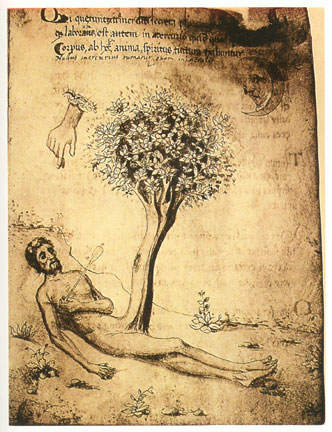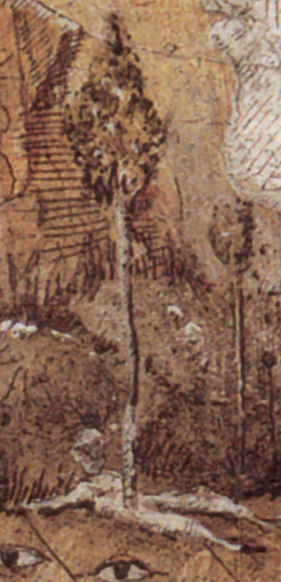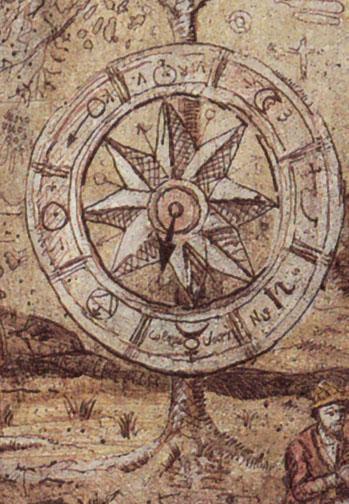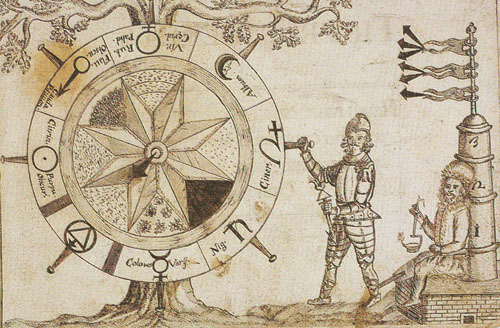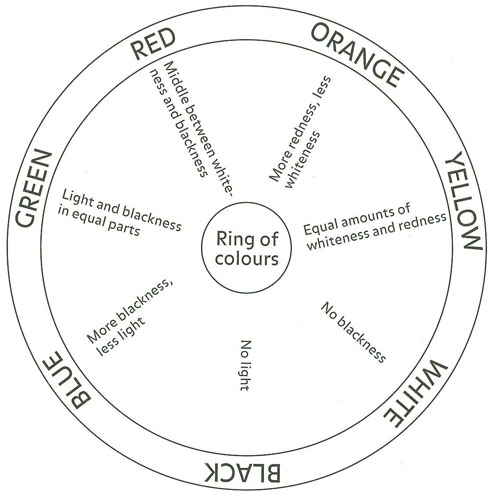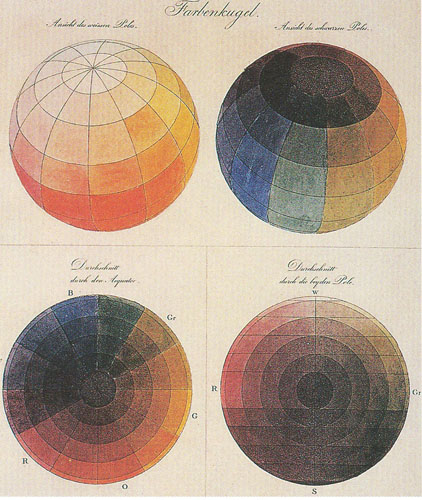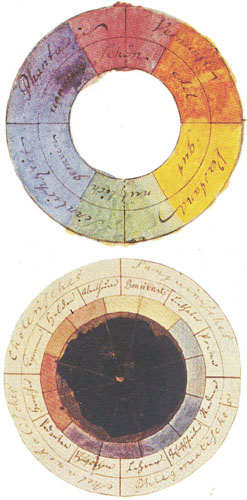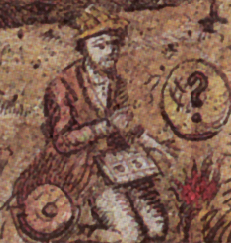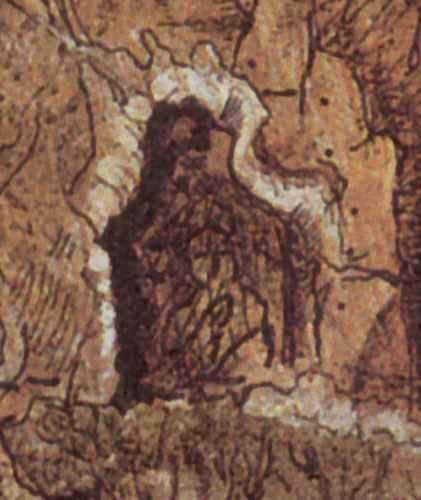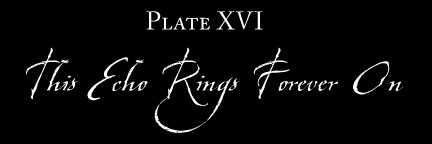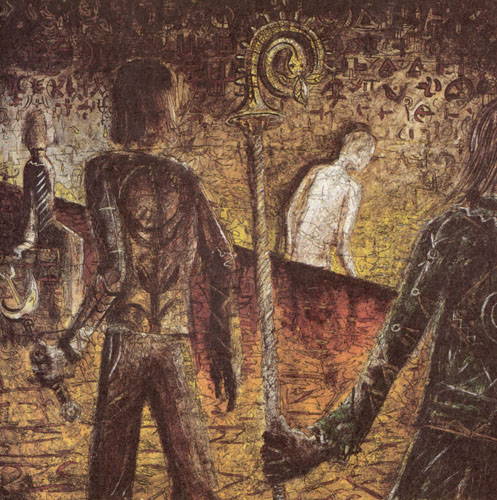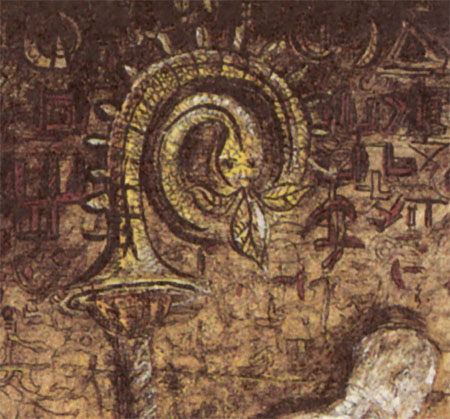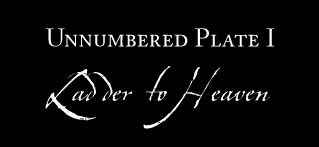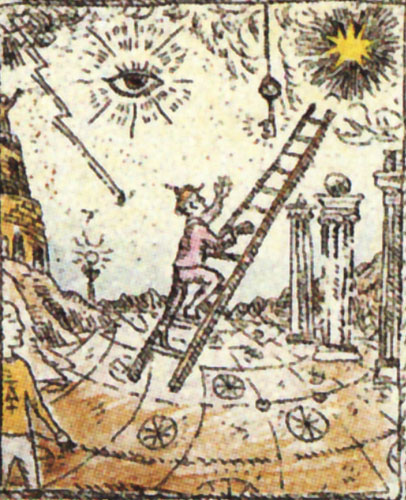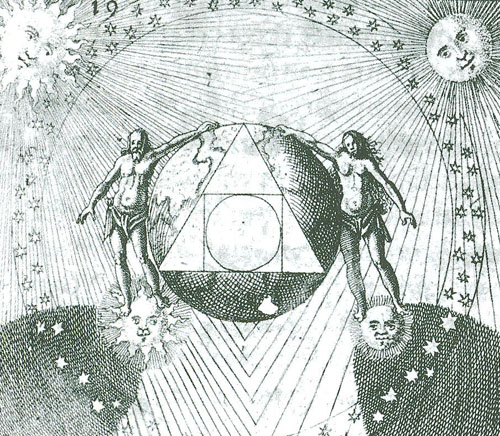
All content & writing by Brad Jaeger © The NACHTKABARETT

PLATE XI |
PLATE XII |
PLATE XIII |
PLATE XIV |
PLATE XV |
PLATE XVI
UNNUMBERED PLATE I |
UNNUMBERED PLATE II

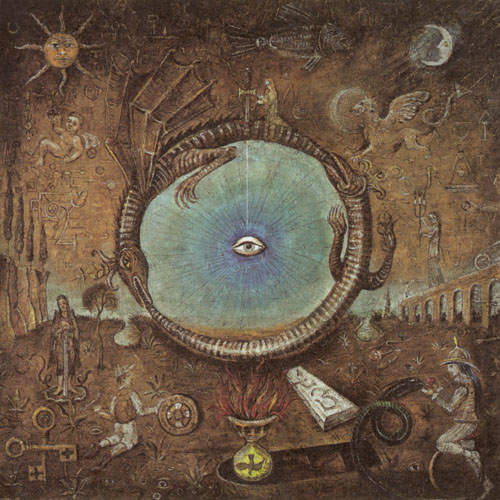
Possibly the single most detailed plate in the entirety of the Machina booklet, this will likewise be the most detailed description.
Beginning with the upper left and upper right corners of the plate, we once again see the marriage of Sol and Luna -the purest of the seven "classical planets"- presiding over the scene watchfully. The appearance of Sol and Luna together as equals once again suggests a certain level of androgynous dichotomy - two aspects of the same original source.
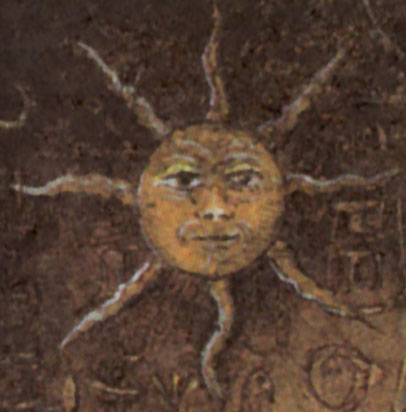 |
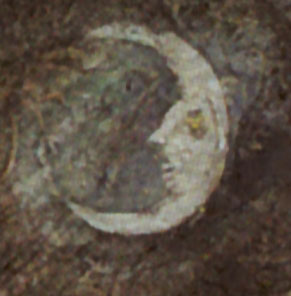 |
|
Left: Sol/The Sun/Gold. Right: Luna/The Moon/Silver |
|
In the lower left hand quadrant of the plate we are witness to God's most righteous angel, St. Michael, resting atop his unsheathed sword, proudly standing over his bested foe, Satan.
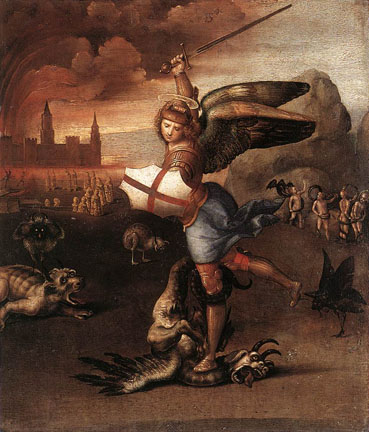
| 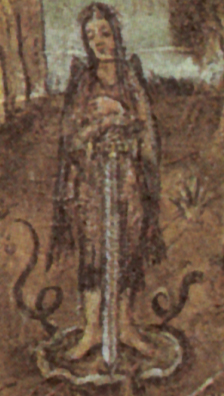 |
|
Left: St. Michael and the Dragon, Raphael, 1515. Right: St. Michael, victoriously standing over the bested serpent |
|
Traditional depictions of St. Michael have often shown him in battle with an unsheathed sword, victoriously laying waste to "that great serpent", or "dragon", which Christian mythology has identified with their concept of Satan.
In the canon of the New Testament, St. Michael is perhaps the most warlike of the archangels, quite possibly due to a particular passage from Revelation in which he is described in battle with Satan and his rebellious angels:
Revelation 12:7-107. And there was war in heaven: Michael and his angels fought against the dragon; and the dragon fought and his angels,
8. And prevailed not; neither was their place found any more in heaven.
9. And the great dragon was cast out, that old serpent, called the Devil, and Satan, which deceiveth the whole world: he was cast out into the earth, and his angels were cast out with him.
10. And I heard a loud voice saying in heaven, Now is come salvation, and strength, and the kingdom of our God, and the power of his Christ: for the accuser of our brethren is cast down, which accused them before our God day and night.
Moving now to the fish, due top and center. The fish, like its role in Plate XIV (Turning Tears Into Oceans, Words Into Sand), once again is symbolic of mercury; the feminine and passive transformational liquid, under whose influence it is possible for great transformations to occur.
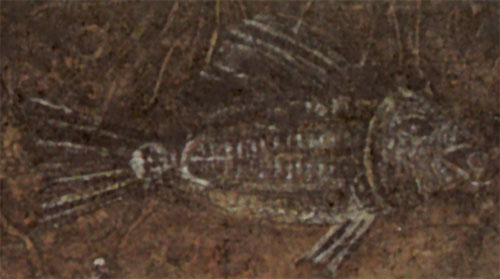 Mercury as represented by the fish, due to its similar liquid and unfixed qualities
Mercury as represented by the fish, due to its similar liquid and unfixed qualitiesLooking beneath St. Michael, we are presented with a set of interlocking keys. The keys appropriately remind the viewer that once the mystery is laid to rest; the solution becomes apparent, effectively revealing all of its secrets to anyone who can solve the intricacies of the pictorial puzzle.
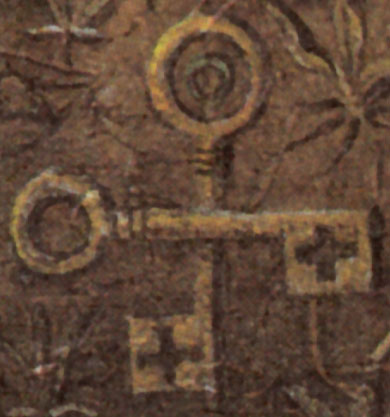 Interlocking keys: gatekeeper, reminder, and riddle. Solve and be rewarded
Interlocking keys: gatekeeper, reminder, and riddle. Solve and be rewardedFrom the keys, if we head to the upper right hand corner, we find a mythological beast known as a griffin. The griffin is a hybrid beast, with the body of a lion and the head and wings of an eagle.
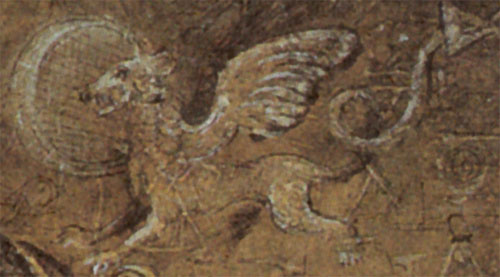 The griffin as illustrated by Vasily Kafanov
The griffin as illustrated by Vasily KafanovIn mythology, the griffin was one of the most feared and respected beasts, having dominion over both ground and air; described as more powerful than dragons, and capable of taking down elephants and other massive land beasts with ease.
Writers, philosophers and alchemists viewed the griffin with even greater appreciation, recognizing it as something almost divine. It's proclivities towards both the terrestrial and the aerial was recognized as being analogue to that of the body and the spirit, both in perfect form. Christian theologians would also attribute it to Jesus of Nazareth, who spent his life on the earth before ascending to the heavenly realm of his father.
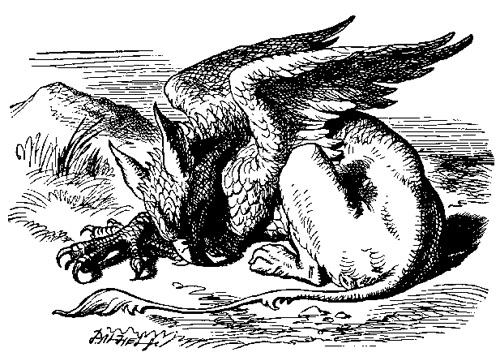 A griffin at rest, as it appears in Lewis Carroll's "Alice in Wonderland"
A griffin at rest, as it appears in Lewis Carroll's "Alice in Wonderland"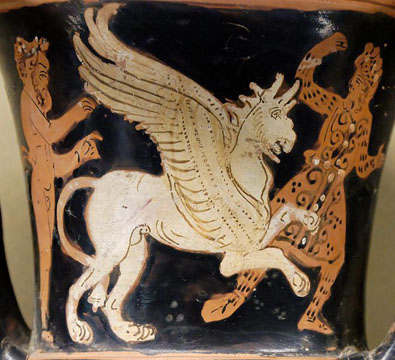 Detail from an Attic red-figure chalice- crater, c.375 - 350 BC
Detail from an Attic red-figure chalice- crater, c.375 - 350 BC They could usually be found guarding something of significant importance; usually treasure, or a religious relic. In our case, the griffin is guarding and protecting the ouroboros, which is the treasure of this plate, containing within it the infinite. We'll get to the ouroboros in a bit later on in this article.
Parallel to the griffin and underneath the sun is a putto holding a quartered circle. The putto is almost always erroneously identified as "cherubim", despite having next to no similar features in their historical depiction or purpose. The putti (plural form of putto) were almost always depicted as pudgy babies, more often than not male, shown at play or in some other form of mirth.
The putti were around at least as early as the 2nd or 3rd century. Originally inscribed upon the sarcophagi of young children, they were shown in scenes of dancing, ritual, or fighting. Somehow they faded away into relative obscurity until their reemergence in Italian Renaissance art, spearheaded by such artists as Donatello, Raphael, and Giovanni da Udine.
As far as their functional purpose goes in terms of Christian lore, they were pretty useless. While they were used as symbols of peace and love, this did not differentiate them from nearly any other celestial being, which usually had the same qualities. Their purpose is murky at best, but they are not shown to be much more than celestial cheerleaders, continually praising and glorifying the perfection of their creator. The putti were an example of a theological concept more inspirational to artists than to actual theologians.
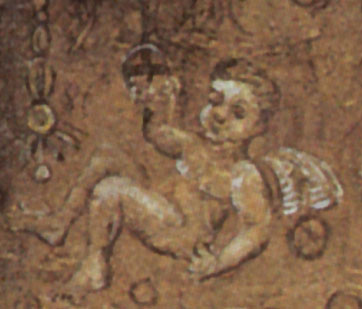 |
.jpg) |
|
Left: A putto as illustrated by Vasily Kafanov for the plate. Right: Festival of Venus (c. 1635) by Peter Paul Rubens(Kunsthistorisches Museum, Vienna. Below: Gustave Doré's illustration of Ludovico Ariosto'sOrlando Furioso, 1877. |
|
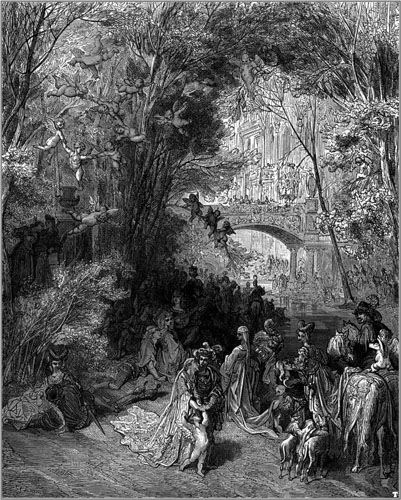
The putto is holding a quartered circle in his right hand. The quartered circle was representative of the world (as the circle), and the cross within it usually related to something divided into four categories: be they the seasons, the four gospels of the New Testament, the temperaments, etc.
The putti is not the only individual in this plate with a quartered circle. A more elaborate quartered circle may be found with the kneeling traveler, his right hand upon the quartered circle as he reverently pays homage to the centerpiece of this plate, the ouroboros.
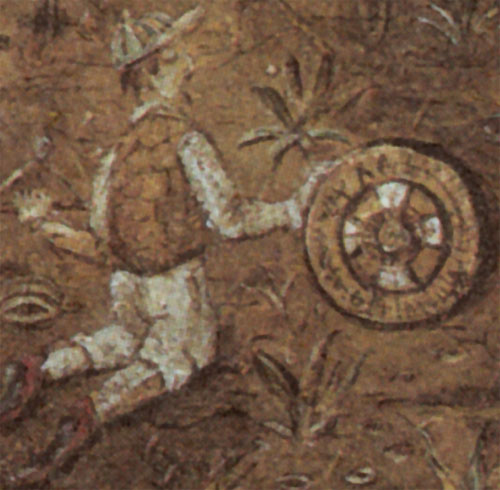 Above: A slightly more elaborate quartered circle than that of the putto.
Above: A slightly more elaborate quartered circle than that of the putto.
Below: "The diagram shows the possible relationships and transformations of the four elements, both between each other and with respect to the four seasons and the temperaments. Earth - autumn - melancholic / fire - summer - choleric/ air - spring - sanguine/ water - winter - phlegmatic." - Alchemy & Mysticism: The Hermetic Museum, by Alexander Roob.
.jpg)
Moving to the bottom right hand corner of the plate, we find a woman to be in the act of snake charming. She is apparently very powerful, as her hat ignites a flame overtop of her head, showing her to be enlightened. While normally a snake charmer would have a flute-like instrument known as a pungi, the woman is controlling the snake with a heart in her hand, entrancing it, showing her mastery not only over herself, but over the hearts of others.
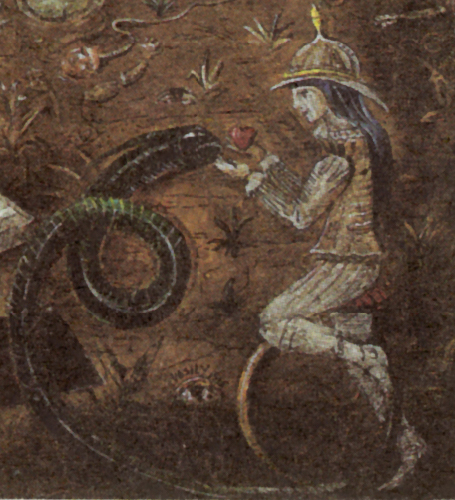 The snake charmer
The snake charmerTo Gnostics, mystics, and generally most cultures other than Christianity, the snake has always been held to be sacred, most prominently perhaps in Hinduism. Unlike today's perception of the snake charmer in which the west looks on it as though it were some sort of sick novelty, snake charmers were often holy men and healers within their community.
The snake charmer can be seen as a parallel to the work of the alchemist, who manifests their desires through the application of their will and through self discovery, learns the secrets of self mastery and oneness with everything.
Turning to the immediate right of the ouroboros, we find two figures side by side, both invoking the same concept.
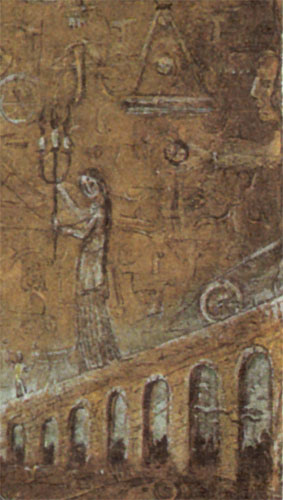 Two figures; one holding a three-split candle holder, the other balancing a triangle with a dot at its center.
Two figures; one holding a three-split candle holder, the other balancing a triangle with a dot at its center.Both figures are invoking the one-god-made-three; the triune concept of the trinity -- one God with three distinct personae.
The invocation of three likely holds a double meaning, tying it to the founder of alchemy - Hermes Trismegistus - otherwise known as Hermes the thrice great. Hermes in all his forms is drawn upon time and time again in Machina, even appearing in a couple of Kafanov's illustrations.
The next symbol worthy of mention lies direct at the bottom center of the plate.
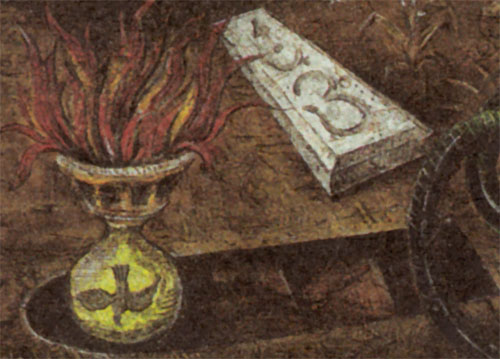
Similar to plate II (The Soul as Living Proof), we once again have a flask with an occupant. This time however there is not a homunculus within it, but a bird and a great flame rising from the flask.What we are witnessing is part of the arduous task of bringing about the Great Work; this is but one part of a long and grueling process through which the lapis is subjected to repeated putrefactions, purifications, distillations, and all other means of transformation in order to transmute it from its original lowly origin to that of perfection; the Philosopher's stone.
Perhaps one of the best examples of this entire process was created by chemistry professor J.C. Barchusen of Leiden, in the early 18th century. Barchusen wrote a treatise called "Elementa chemicae" which detailed two possible paths to obtain the Philosopher's Stone. The first was a short, "dry" path characterized by the separation of matter via external flame and "the involvement of a secret inner fire". The other process was more arduous and known as the 'wet' path, which was characterized by repeated distillations.
Forever keep in mind that these plates are allegorical and chalk full of metaphor - to merely transmutate a lesser piece of matter to a more evolved state is relatively simple. The transformation the alchemist yearned for was self transformation. This was achieved by surrendering the material body, and subjecting it to tests which would bring about the shift from matter to pure and ineffable spirit, achieving oneness with the creator and all of his work.
As Paracelsus famously wrote in Paragranum,
Nature brings to light nothing that is perfect, but man must perfect it. This perfection is called alchima. An alchemist is the baker when he bakes bread, th e viniculturist when he makes wine, the weaver when he makes cloth.
Roob wrote a synopsis of the entire process which is quite eloquent and to the point:
The material spirit is extracted from it. The legendary Azoth comes, as the agent of the Work, in the form of a dove. Like the doves that Noah sent forth to learn whether the waters had abated, it only ends its flight when the lapis is finally fixed.Alchemy & Mysticism : The Hermetic Museum
I will now provide several of Barchusen's plates along with his original commentary. I have started with the eighteenth plate - just a bit before the stage of the Great Work that is visible in Vasily Kafanov's plate - for the curious, I have offered several stages thereafter, highlighting some key aspects of the alchemical journey towards perfection.
.jpg)
Philosophical quicksilver consists of liquid, mercurial components (Azoth) and solid sulphurous parts (Latona). The bird is the mercurial "spirit" that carries out the Work.Plate 18 of Elementa chemicae by J.C. Barchusen, Leiden, 1718
.jpg)
The state of putrefaction: here the four elements separate and the soul emerges from the body. The ascending bird represents the distillation of philosophical mercury. The descending bird indicates that the distillate must be repeatedly poured on to the physical residuePlate 20 of Elementa chemicae by J.C. Barchusen, Le iden, 1718.
.jpg)
"Putrefaction is the gate to the conjunctio, and conception. It is the key to transmutation. The star indicates that the matter is self enclosed, and that the seeds of the seven metals lie within it.Plates 24 and 25 of Elementa chemicae, by J.C. Barchusen, Leiden, 1718
.jpg)
The appearance of Apollo and Luna announces that the stone will soon have the capacity for transmutation.Plate 37 of Elementa chemicae, by J.C. Barchusen, Leiden, 1718
.jpg)
The final solidification (fixatio) of the lapis, which rises as a phoenix in the flames.Plate 47 of Elementa chemicae, by J.C. Barchusen, Leiden, 1718
.jpg)
Azoth is poured on once more (58), and the intensity of the fire is raised (59-60), for the soul must be "sweated out" (61).Plates 58 through 61 of Elementa chemicae, by J.C. Barchusen, Leiden, 1718
.jpg)
In a torture by fire lasting several days, the stone now matures to its perfection and resurrection.Plate 74 of Elementa chemicae, by J.C. Barchusen, Leiden, 1718
.jpg)
After much suffering and torment I was resurrected large, pure and immaculate." Spirit and soul have now completely penetrated the body, father and son are united, transience and death have lost all their power.Plate 78 of Elementa chemicae, by J.C. Barchusen, Leiden, 1718
The flask also notably lies within what appears to be a grave or coffin. If so, this would reinforce the principle of transformation, from putrefaction to purification, death to new life.
The inscribed stone tablet lying to the side may itself be the covering for the coffin, but that is a speculative statement at best.
We've finally arrived to the centerpiece of this plate: one of the oldest esoteric symbols known to man, and without a doubt one of the most prominently used symbols during the Machina Era. The all devouring serpent -the ouroboros- first appeared in its now recognizable form in Ancient Egypt, circa 1600 BCE. Its name is Greek in origin and means "tail devourer".
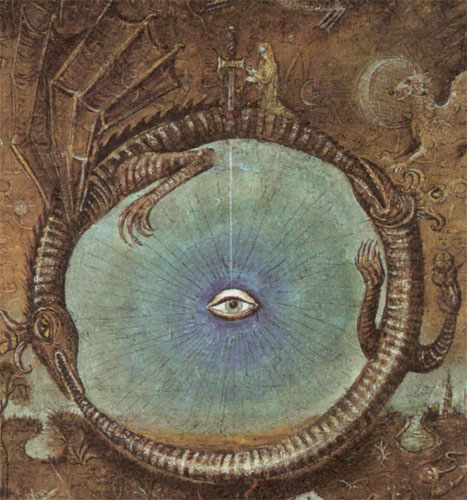 The cyclical nature of the ouroboros, who feeds upon his tail; creating a permanent and infinite ring
The cyclical nature of the ouroboros, who feeds upon his tail; creating a permanent and infinite ringThe ouroboros is traditionally depicted as a serpent or dragon in the process of swallowing its own tail, resulting in the formation of a circle. Unsurprisingly the ouroboros is most often regarded as a symbol of infinity and renewal, though it is also widely interpreted to be demonstrating the principles of cyclical transformation and the creation of life through death. It has also been used as a symbol for totality, self-sufficiency, androgyny, mercury, and truth.
From a Gnostic and Hermetic perspective, the ouroboros was a symbol of pure light, which permeated throughout the universe and encapsulated within the soul. Some viewed the serpent as the physical manifestati on of the ouroboros, wisest of all God's creatures, present in the Garden of Eden when Adam & Eve were banished for the act of free will; obtaining gnosis and knowing good and evil.
The philosopher sage Plato wrote of the Ouroboros in his Socratic dialogue, Timaeus (360 AD). In the theoretical treatise, Plato describes the Ouroboros as the first living creature in the universe, perfect in design:
The living being had no need of eyes when there was nothing remaining outside him to be seen; nor of ears when there was nothing to be heard; and there was no surrounding atmosphere to be breathed; nor would there have been any use of organs by the help of which he might receive his food or get rid of what he had already digested, since there was nothing which went from him or came into him: for there was nothing beside him. Of design he was created thus, his own waste providing his own food, and all that he did or suffered taking place in and by himself. For the Creator conceived that a being which was self-sufficient would be far more excellent than one which l acked anything; and, as he had no need to take anything or defend himself against any one, the Creator did not think it necessary to bestow upon him hands: nor had he any need of feet, nor of the whole apparatus of walking; but the m ovement suited to his spherical form was assigned to him, being o f all the seven that which is most appropriate to mind and intelligence; and he was made to move in the same manner and on the same spot, within his own limits revolving in a circle. All the other six motions were taken away from him, and he was made not to partake of their deviations. And as this circular movement required no feet, the universe was created without legs and without feet.
Alchemically, the ouroboros has been a longstanding symbol which demonstrates the unity of dichotomy and opposites, bringing together good and evil, the conscious and the unconscious, the Yin and the Yang, balance and chaos. It was often compared with the Phoenix in lieu of its shared trait of immediate regeneration upon its demise.
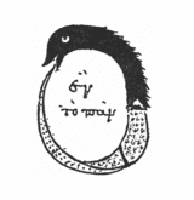
Above: The Ouroboros, as drawn in the alchemical text, "The Chrysopoeia of Cleopatra", dated around the 2nd century. Within the serpent are the words "hen" and "pan", meaning "the one", and "the all". In other words, "All is one". The black and white portions of the ouroboros are common in Gnostic depictions for the duality of existence, with the black half representing the physical, the night, the Earth and the tangible; conversely, with the lighter half representing the day, the Heaven(s) (or pleroma), and the intangible. It should be noted that the ouroboros should not be interpreted as being in a state of conflict, but rather in unity, despite the apparent dichotomy of the illustration.
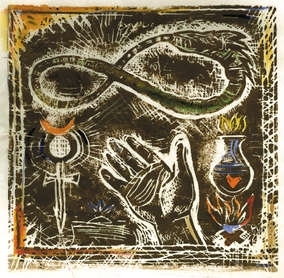 |
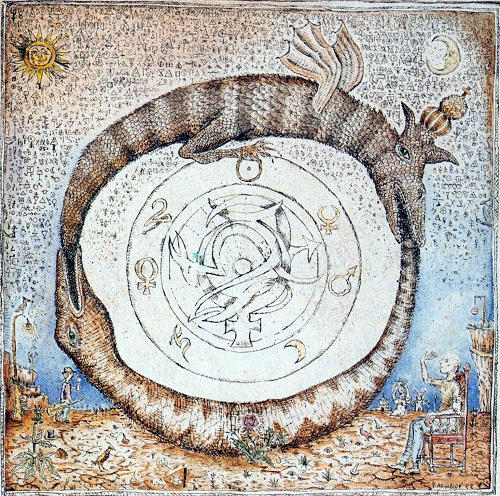 |
| Two other depictions of the ouroboros created during the Machina era. The first depicting the ouroboros encoiled in the lemniscate symbol to reinforce its quality of the infinite, and the second image depicting a ouroboros encircling the hermetic maxim, "it is finished when seven are one". The ouroboros would also be used in a series of flash files which featured on the main site over the years. | |
 |
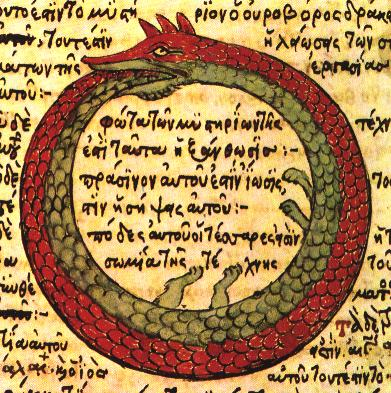 |
|
| Various depictions of the Ouroboros throughout the ages | ||
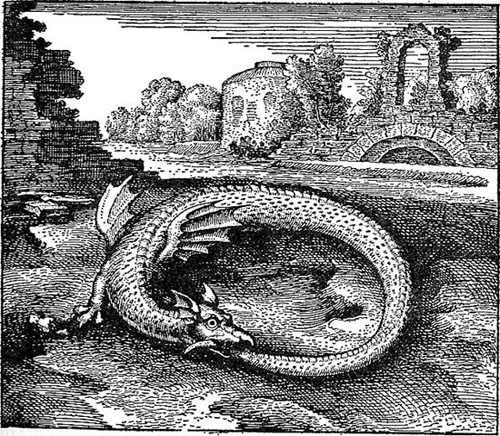
Atop the ouroboros is a woman enshrouded in holy garments, kneeling in reverence before a ceremonial sword. As a gesture of respect and reverence, kneeling is done before something you place higher stock in than yourself. This is the purpose of kneeling in Catholic mass, or before a monarch - to freely acknowledge your servitude and subservience. In this case, the sword penetrates the cyclical serpent, and drives deep into the void and infiniteness of creation..
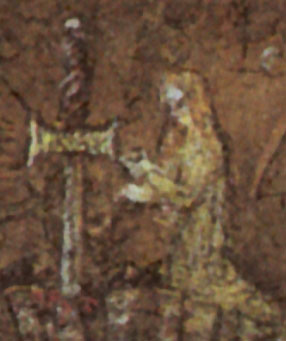 Woman in reverence towards the ouroboros
Woman in reverence towards the ouroborosOne final sy mbol is worth our attention. Located directly in the center of the ouroboros, we have another extremely well known symbol, called "the all-seeing eye of providence". It has been used by alchemists and artists extensively for centuries, and is still part of the iconography of the Freemasons, who refer to God in non denominational terms as "The Grand Architect of the Universe". To the masons, the eye reminds them that all of their actions are observed by God and that their deeds while on this earth are to be charitable and in good will.
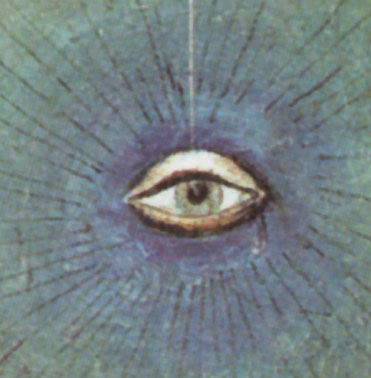 |
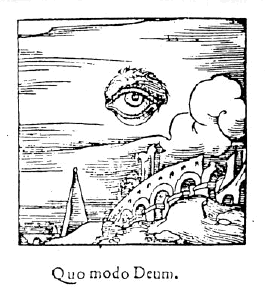 |
|
Left: The all-seeing eye of providence. Right: A similar depiction from an alchemical woodcut. The text reads, "Quo modo Deum", which is Latin for "This is the way of God" |
|
Despite popular misconception, the all-seeing eye is not an inherently Christian symbol, and predates most of their usage. The truth is that it likely derives from a similar Egyptian symbol known as the eye of Horus. Christianity would later appropriate this symbol, supplementing it with the addition of a triangle which encases it. This is the familiar symbol on the back of the American one dollar bill, and the triangle is yet again another reference to the trinity.
A final interesting note is that the title of the plate (The I of the Radio) serves as wordplay, referring to the eye contained within the ouroboros.

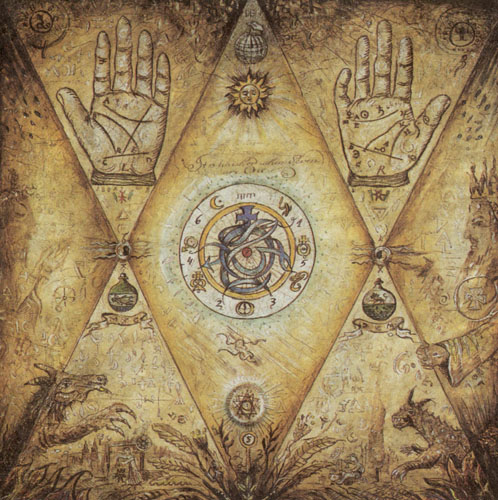
Showcasing one of the most prominent and recurring symbols within Machina: the hermetic maxim, "It is finished when seven are one". Directly above it lies the sun, and the earth suspended by the hand of God. To its left and right are hands which bear the seven planetary symbols, and recall the act of chiromancy. On opposing sides are a king and queen; both with great beasts at their heel. Along the bottom are a man and a woman, both at work. In flasks below both hands lie homunculi .
The focal point of the plate is quite obviously the alchemical treatise in the center of the plate. Contained on the front cover of the album, and found in numerous hidden websites and standalone flash videos (all of which the NACHTKABARETT intends to cover), it is apparent that the symbol was crucial and perhaps central to the thematic concept of Glass and the Machines of God, as presented by Billy Corgan for the album. On a personal note, the symbol holds so much beauty and truth within it, that I had it tattooed upon my arm. So I'll take pleasure in its description, as it holds a special significance to me.
"It is finished when seven are one" is an occult concept revolving around the seven classical planets (Mercury, Mars, Venus, Saturn, Jupiter, the Sun & the Moon), with a single symbol in the center – an amalgamation of all seven symbols. As was the case with most alchemical concepts, the true intent of its teachings were clouded in allegory and metaphor to keep the gnosis hidden from the public. Only those with the full capacity to properly comprehend the subject matter could attain its meaning.
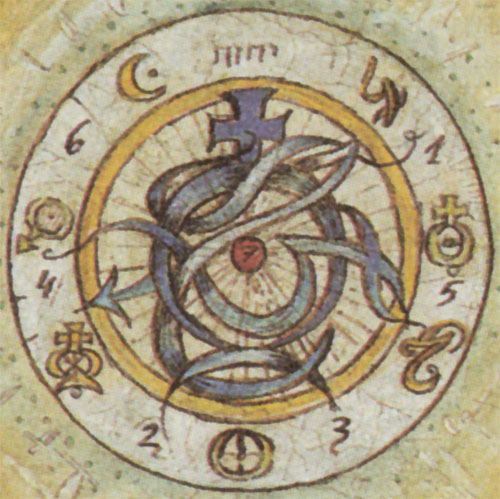 "It is finished when seven are one". Kafanov's depiction shows the name of God at the top, and moving counterclockwise around the circle are the symbols for: Jupiter, Venus, Saturn, Sun, Mercury, Mars, Moon – the classical planets of ancient astrology.
"It is finished when seven are one". Kafanov's depiction shows the name of God at the top, and moving counterclockwise around the circle are the symbols for: Jupiter, Venus, Saturn, Sun, Mercury, Mars, Moon – the classical planets of ancient astrology.On the surface, the treatise reflected the notion of transmuting base metals and refining them into the divine mixture. But this was only a metaphor for a much more profound spiritual concept.
When the Alchemist discovers the proper mixture and balance of the base elements; Quicksilver (Mercury), Iron (Mars), Copper (Venus), Lead (Saturn), Tin (Jupiter), Gold (the Sun), & Silver (the Moon), they create the divine mixture, symbolic of the spiritual ascension of the alchemist. It is not the elements themselves which bring about the transformation, but rather, the journey and manifestation of the true Will of the alchemist which causes this spiritual ascension. When this occurs, the alchemist becomes one with everything material and immaterial. And so, one can only truly accompany the all, when everything unifies and is reduced to the one.
Kafanov reinforces this concept by numbering the elements from one to six. In the center he places the seven to reiterate the reduction of the all to the one.
The reference for this can be found in D.A. Freher's 'Paradoxa Emblemata', an 18th century manuscript.
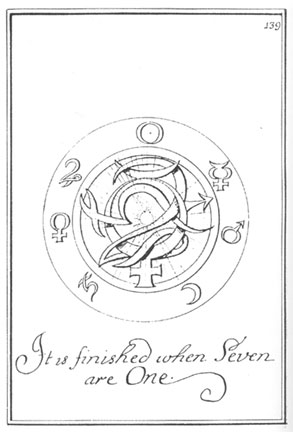
It Is Finished When Seven Are One. "'The curse of God has entered the seven figures, so they are in conflict with one another.' Just as the human will was transformed 'into eternal sun, calm in God,' 'so in the Philosophical Work must all figures be transformed into one, into Sol. From seven must come one, and yet it remains in seven but in one desire, as every figure desires the others in love, so there is no longer any conflict.' (Jacob Böhme, De signatura rerum). D.A. Freher, Paradoxa Emblemata, manuscript 18th century.Alchemy & Mysticism: The Hermetic Museum by Alexander Roob
If we move out, towards the top left and right corners of the plate are two hands, palms facing outwards, emblazoned with many symbols: each palm concentrated on its own particular focus, but both palms being related to the form of divination known as chiromancy (informally called 'palm reading').
Chiromancy was once an esoteric art and divination tool; an ancient Indian astrological tool of mysticism, used for everything from personal insight to prophecy, but today largely diluted and reduced to trickery by new-age profiteering 'psychics' seeking material gain.
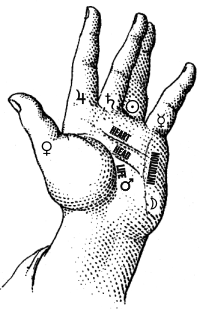 |
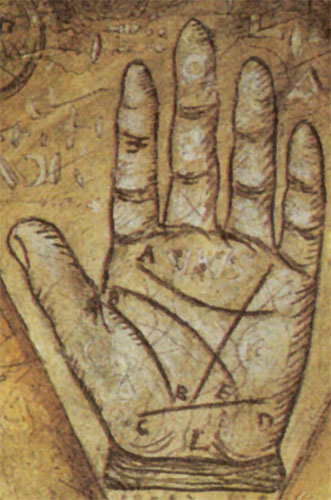 |
|
Above left: An illustration showing the location of prominent lines used in chiromancy, including: the heart line, the head line, and the life line. Also visible are the symbols of the classical planets. Above right: Kafanov's palm falls in line with traditional depictions. Once again, the prominent lines are all clearly defined. |
|
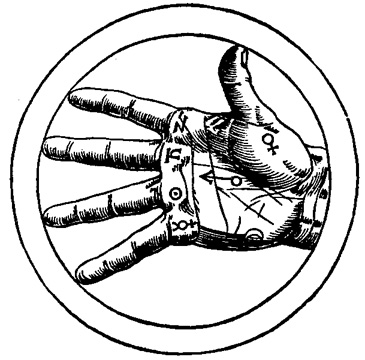 |
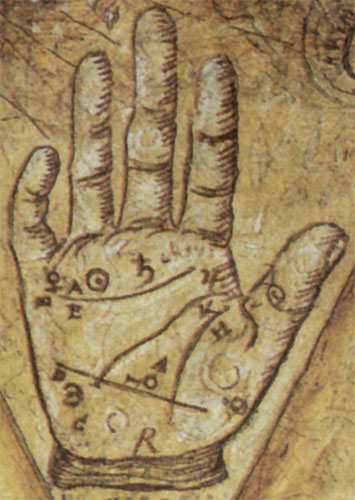 |
|
Above left: A diagram by the great 16th century occultist Heinrich Agrippa detailing the location of the planetary influences on the palm. Above right: Kafanov's depiction, keeping holding true to Agrippa's early illustration. |
|
The planets located on the palm are the classical planets of ancient antiquity (Mars, Mercury, Venus, Jupiter, Saturn, Moon, Sun) – the very same planets which are also evoked in the alchemical treatise "It is finished when seven are one" at the center of the plate.
Friday Press writes of the significance of the planets on chiromancy:
Venus is thumb fertility & abundance. The fleshy base is Mount of Venus, area of love, sympathy & passion, the life-line curves around it.
Jupiter is forefinger self-confidence, faith, ambition & social prestige, heart-line begins at its base and extends to outer edge of hand.
Saturn is middle finger sobriety, self-discipline & self-respect, the fate-line extends from base straight down to the wrist.
Sun is ring/gold/leech finger healing & ruler of the heart, the sun-line extends from the base straight down to the wrist.
Mercury is pinky/ear finger learning & teaching, conductor of dead souls, the health-line follows the angle of this finger diagonally across the palm.
Moon is fleshy mound below pinky intuition, imagination & subjective knowledge, below and supporting the realm of Mercury, line of intuition is found in this section of the hand.
Mars is central palm area strength & vitality, the strong head line crosses diagonally through this area.
Moving on, flanking the left and right sides of the plate, we see two royal figures.
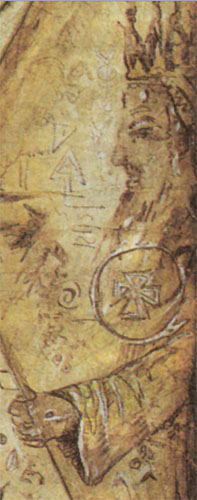 |
 |
| King and queen representing two aspects of the alchemical androgyne. The king bears a prominent crown, signifying the rule of man and law, as well as authority and order, and is likened to the qualities of hot and fixed sulfur. The queen as his antithesis bears a crown of nature, signifying the intuitive and earth-nurturing quality, in line with the feminine traits of volatile mercury. | |
Continuing on with the balancing of opposites, one might notice a pair of dual triangles with homunculi within them.
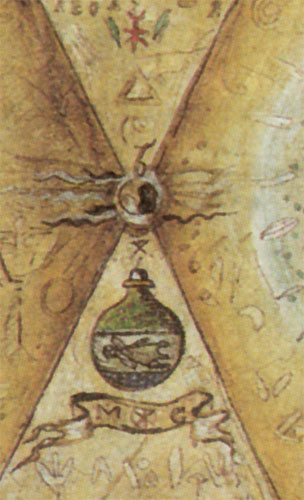 |
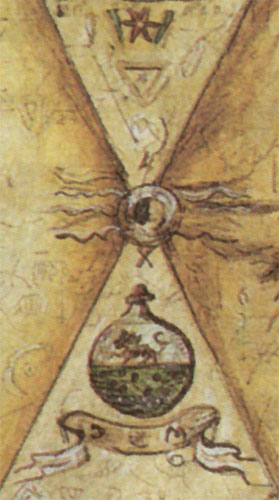 |
| Each illustration shows a large triangle base, with its mirror image inverse atop it. While the left image has a yin-yang flourish that is white on its left side and black on its right; the right image reverses this. Similarly, in the left image, the top inverse triangle base has a smaller triangle within it; once again, the right image has a triangle in the same location, but inversed. Additionally, on the ribbon below each, are the initials "M" & "G" and conversely "G" & "M". | |
The homunculi figures trapped in the flasks are not so much dichotomies, but rather, in two separate stages of the work. The first homunculus on the left is shown with its ethereal spirit caught between fixed earthly qualities, and transiently volatile mercurial qualities. The homunculus on the right has separated the ethereal and divine from the base and material, and the emergence of the green lion; the physical embodiment of vitriol.
Resting along the bottom of the plate, to the immediate left and right of the plant, we find our next subject.
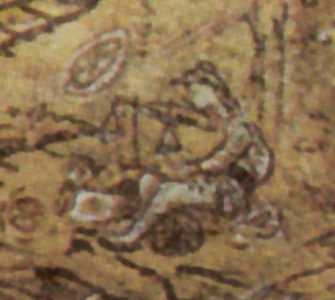 |
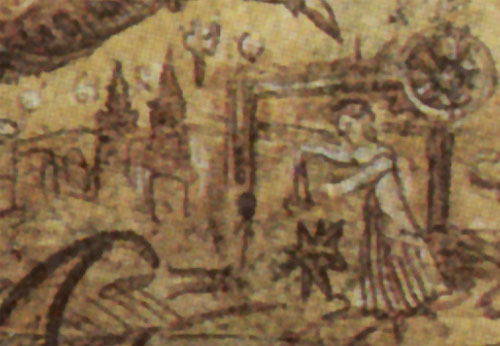 |
| Man and woman, shown at work. While clarity issues make determining what task the woman is about rather difficult (is that a water wheel, or well? Is her hand above a flame?), the man is shown more clearly, balancing a set of scales; paralleling the work of the alchemist, who seeks balance of another sort. | |
The physical act of a man and/or woman shown at work is a common motif in alchemical symbolism, and analogue to that of the great work of the alchemist who journeys through the inner workings of the self in order to bring about their own transcendence. Thus, the concept of the spiritual work of the alchemist was often told in metaphor through physical, practical forms, exemplified by the common worker.
Finally, if we turn our attention back to the top of the plate, dead center, we'll see our last topic of interest.
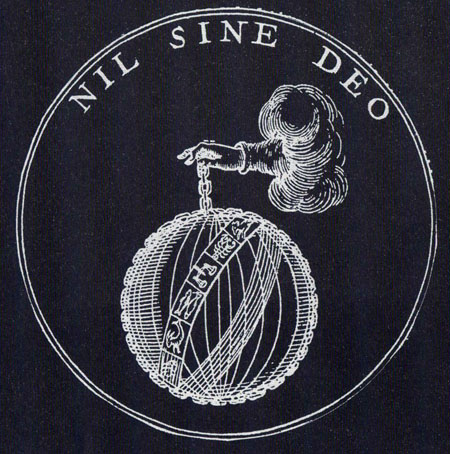 |
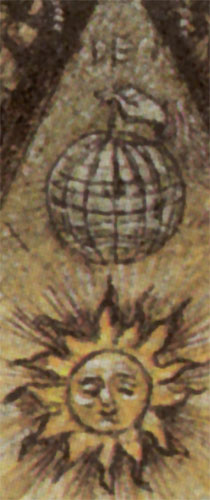 |
| "For Plato, the universe or great world order was created by God the creator as a manifestation and illustration of his own perfection: "(...) and so he formed it as a single visible living thing which was to include all related creatures (...). By turning it he shaped it into a sphere (...), giving it the most perfect form of all." (Timaeus, c. 410 BC) | |
Above Left: The hand of God suspends the earth from a link chain. Above it reads "Nil Sine Deo" (Nothing without God). Image taken from Alexander Roob's "Alchemy & Mysticism: The Hermetic Museum".
Above Right: Vasily Kafanov's hand of God, presiding over the Earth. Above it reads "Deo" (God). This is the second plate which evokes Nil Sine Deo (Plate III: The Chemist Brings Spark being the other).

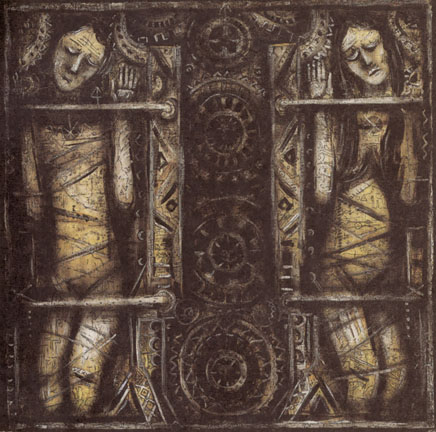
Glass and June, doomed by fate and circumstance. Like the androgyne, split between the embodiments of male energy and female essence, blurring the distinction of male and female. Entombed in cold, mechanical coffins, Glass and June are literally represented as another cog in the "The God Machine", symbolic of their symbiotic union with the machine (the same machine in which they initially set out in opposition against).
Bound by steel ring harnesses, encased in makeshift tombs of metal, the plate equally reflects hope and tragedy; an inner light within overwhelming darkness, the simultaneous coldness of humanity juxtaposed with the soul's ability to stir forth the greatest of human potential.
Two opposing, yet related interpretations are evident. In the first, the two are encased in metal, becoming just another gear within the mechanism of the machine. Devoid of freedom and their humanity, they are left hollow and mechanical, paralleling much of the blurred continuum between Zero and Glass and the Machines of God.
Conversely, a slightly more hopeful interpretation may also be provided. Within the mechanical casing of even the most cold and disconnected machine (take that figuratively or literally) lays the light of the human soul, yearning to surface.
This is perhaps one of the few reassuring qualities we can think of when discussing Glass. Zero and Glass, while separate personae, are not truly separate beings, but rather reflections of different qualities and aspects of the same individual. Likewise and self admitted by Billy Corgan, Glass and June are not so much different entities, but rather, personifications of different aspects of the same individual, containing in them elements of each other:
June in the story really embodies the female essence against Glass' male energy, but Glass is sort of an androgynous figure, and in some ways the feminine June has some male characteristics, so the lines are constantly blurred in the story.Excerpt of an interview with Billy Corgan about the web animation series, "Glass and the Machines of God"
Additionally, the title of the plate, TORN INSIDE MACHINES OF LIGHT, suggests the symbiotic relationship between man and machine, uniting both in the pursuit of the light: wisdom, life, love, transcendence, enlightenment. And all that that entails.
Between the cuts and bruises a few random alchemical signs are marked on their bodies, but they are not at the forefront of this plate like in many others, as this particular plate is more pronounced by the figures lying in their tombs of metal than in the cohesion of alchemical symbols that express a sentiment.
That being said, fire and water signs appear occasionally, mostly in the form of triangles and their inverse. The sign of Sol and another of earth can also be detected upon close inspection. The inclusion of fire and water signs denotes a union of dichotomy, both applicable in the alchemical union of Zero/June or Zero/Glass.
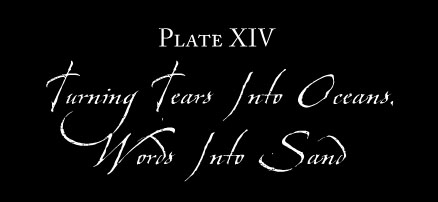
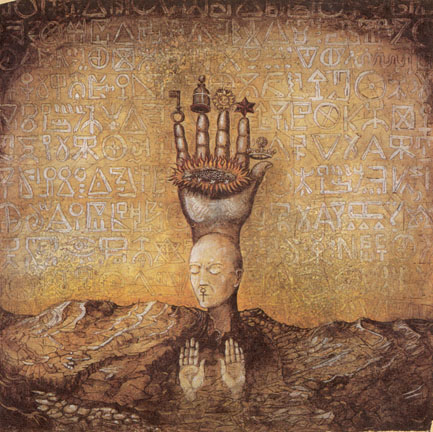
The plate is likely inspired by The Secret Teachings of All Ages: An Encyclopedic Outline of Masonic, Hermetic, Qabbalistic and Rosicrucian Symbolical Philosophy, by Manly P. Hall, published in 1928. Hall's diagram, as beautiful as it is, was actually redrawn from an earlier 18th century watercolour by an unnamed artist.
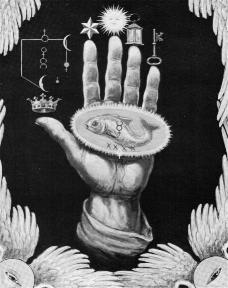 |
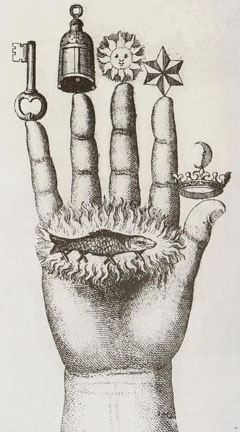 |
|
Left: Drawing by J. Augustus Knapp from an earlier 18th century watercolour. Featured in 33° Manly P. Hall’s, ‘Secret Teachings of All Ages’. Right: Another depiction in "The Hermetic Museum" by grand occultist Alexander Roob |
|
The image depicts the philosopher's hand revealed. Alexander Roob would write of it, "This is the hand of the philosophers with their seven secret signs, to which the ancient sages were bound." To the initial adept, it is closed as a fist and can only be properly opened to reveal its mysteries to the right individual and under the right circumstances.
The hand gives the secrets of the formula necessary for the production of a tincture known as physicorum. The fish, representing Mercury and its bed of flames as sulfur begins the process through which each of the fingers bears a key to the completion of the great work.
Instructionally, the unknown artist states: "The wise take their oath by this hand that they will not teach the Art without parables". In alchemy, and indeed, all of the occult, this common practice. One cannot simply divulge information pertaining to the great work, as those unprepared will likely not be able to make anything of it, yet alone bring about any sort of spiritual enlightenment from it. I'm of a differing opinion, and if that is indeed the case, than wisdom will fall on deaf ears, and harm's none to hear it.
That being said, the symbols are not altogether uncommon in alchemy and many may be recognizable to followers and non-followers of alchemy alike:
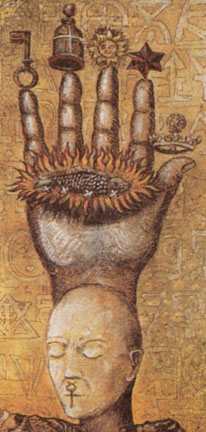
- The Crown (Thumb): From a Kabbalistic standpoint, the crown is symbolic of Kether, the source of all creation and the first sephira on the Tree of Life. It also emits pure, radiant and absolute light. The powerful representation of saltpeter.
- The Star (Index): The Universal Light which permeates the universe and reveals the truth of all heavenly and celestial wonders. The all penetrating representation of vitriol.
- The Sun (Middle): Brilliantly shining, the sun is like the abstract mind, whose light extends past all borders and limitations of darkness, allowing us to extend past the conventional and examine the secrets and mysteries of our existence. The luminous representation of sal ammoniac.
- The Lantern (Ring): The illumination provided by the concrete mind. Human knowledge and wisdom, guiding us always, provides us with the light and guidance to seek the greater truths. The gleaming representation of alum.
- The Key (Pinky): The key which reveals the secrets of all the mysteries. The tool necessary to unlock the æther body, with the ability to access the transcendent reality. The lock-and-key representation of common salt.
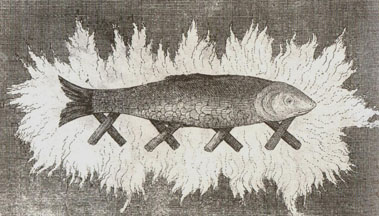 The fish, denoting mercury, rests in the middle of the hand and sulfur, the bed of fire, provides its bed. The union of mercury and sulfur, fire and water, man and woman, marks the beginning and end of the act, the completion of harmonious union
The fish, denoting mercury, rests in the middle of the hand and sulfur, the bed of fire, provides its bed. The union of mercury and sulfur, fire and water, man and woman, marks the beginning and end of the act, the completion of harmonious unionNumerous alchemical and occult symbols serve as the background. Of those include (but are not limited to): mercury, sulfur, fire, water, earth, air, Sol (the sun), the fish (double meaning of both being a depiction of mercury, as well as an early symbol adopted by Christians). Geometric shapes also populate the background with wheels, spirals, split circles and squares cut into quadrants. Runic influence is also present as Man (M) and Beorch (B) is clearly present (a little above and between the sun and the star) and several other letters are written in a similar Anglo-Saxon Futhorc.
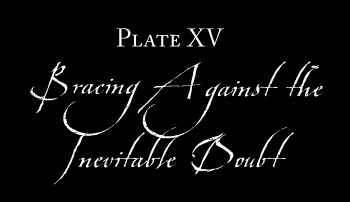
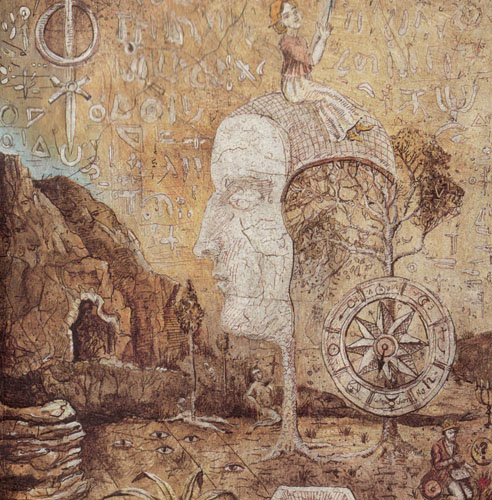
A woman holding a book sits atop the face of a man grown like a tree, while the philosophical man to its left grows a similar structure from his core. Affixed to the tree on its right is a philosophical colour-wheel. Beneath the wheel we see an alchemist bring forth fire as he studies the great mystery before him. Another man meditates upon the same mystery in the isolation provided by a great cave. Under the largest tree, a figure wielding a cross looks upon it in awe, as the omniscient eyes of the earth watch everything.
In the lower left quadrant of the image and to the immediate right of the cave, lies the philosophical tree:
